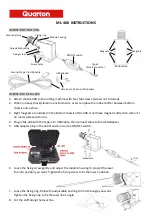
System Overview
R&S
®
ZVA
96
Getting Started 1145.1090.62 ─ 13
For a given RF signal, an ideal mixer would produce only two IF outputs: one at the
frequency sum of the RF and LO (IF = RF + LO), and another at the frequency differ-
ence between the RF and LO (IF = |RF – LO|). Filtering can be used to select one of
these IF outputs and reject the unwanted one.
In the scalar mixer mode the analyzer provides the following functionality:
●
Configuration of the RF and LO signals and measurement of the generated IF sig-
nal.
●
Power calibration of the signal sources and of the IF receiver.
●
The mixer mode can be used also to test important performance parameters of RF
mixers such as frequency ranges, conversion loss, compression, and isolation.
Harmonics are signals at an integer multiple of the fundamental frequency. The funda-
mental is the first harmonic, the nth harmonic is n times the frequency of the funda-
mental. The production of harmonic frequencies by an electronic system when a signal
is applied at the input is known as harmonic distortion.
The purpose of the harmonics measurement is to measure the harmonic distortion of a
DUT. To this end the source remains at the fundamental frequency whereas the
receiver is set to n times the fundamental frequency. Two different types of results are
provided:
●
In the direct measurement, the n
th
harmonic of the stimulus signal is measured.
●
In the relative measurement, the n
th
harmonic of the stimulus signal is divided by
1
st
harmonic (fundamental) received from the DUT. The result corresponds to the
n
th
harmonic distortion factor.
3.5.4 Mixer Phase Measurement (R&S ZVA-K5)
Measurement of the parameters of an external mixer including phase, e.g. the complex
conversion loss or reflection coefficients. In contrast to scalar mixer measurements
(with option R&S ZVA-K4), mixer phase (or vector mixer) measurements provide mag-
nitude and phase information, including group delay, about the mixer under test (MUT).
To assess the phase information, the IF signal at the mixer output is converted back to
the original RF frequency using a second MEAS mixer. A third REF mixer ensures that
the reference wave is converted back to the RF frequency.
3.5.5 True Differential Mode (R&S ZVA-K6)
Differential transmission lines and circuits are widely used, because their characteris-
tics give them a lower susceptibility to electromagnetic interference. Linear balanced
devices can be tested with sufficient accuracy using the virtual differential mode, where
the vector network analyzer generates unbalanced stimulus signals and uses a mathe-
matical transformation to convert unbalanced wave quantities into balanced S-parame-
ters. A different behavior is expected for nonlinear balanced devices, where the trans-
mission characteristics of the DUT may depend on how closely the stimulus signal
matches real operating conditions.
Optional R&S
ZVA Extensions











































